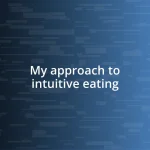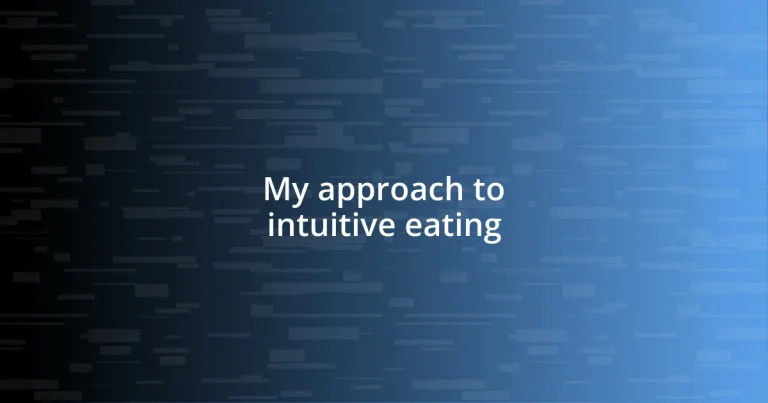Key takeaways:
- Intuitive eating emphasizes listening to your body’s hunger and fullness cues, fostering a healthier relationship with food.
- The core principles include rejecting diet mentality, honoring hunger, challenging food police, and fostering self-compassion.
- Sustaining intuitive eating habits involves continuous self-awareness, supportive environments, and regular reflection on personal intentions.
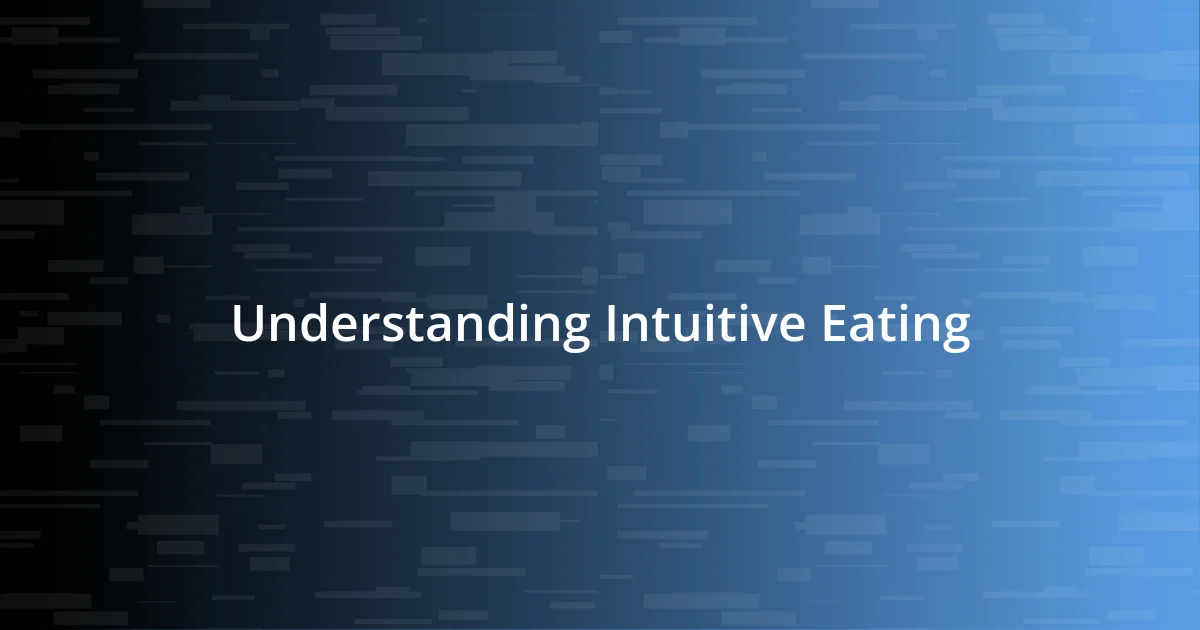
Understanding Intuitive Eating
Intuitive eating is about tuning into your body’s natural hunger and fullness cues rather than adhering to strict diets or external rules. I vividly remember the moment I first connected with this concept; after years of dieting, I finally let go of the guilt that came with food choices. Have you ever thought about how liberating it feels to simply eat when you’re hungry and stop when you’re satisfied?
At its core, intuitive eating promotes self-compassion and respect for your body. I recall a time when I indulged in a second slice of cake, not out of necessity, but because it brought me joy. It was refreshing to realize that pleasure in eating doesn’t have to trigger feelings of shame or remorse. Isn’t it empowering to think we can enjoy our meals without the guilt often associated with food?
What’s truly fascinating to me is the shift from dieting mentality to a more intuitive approach; it can be a journey filled with ups and downs. I once found myself truly questioning what my body needed instead of what I thought I should eat. Can you relate? It’s in those moments of reflection that I discovered the beauty of listening to my own body—an experience that has transformed my relationship with food.
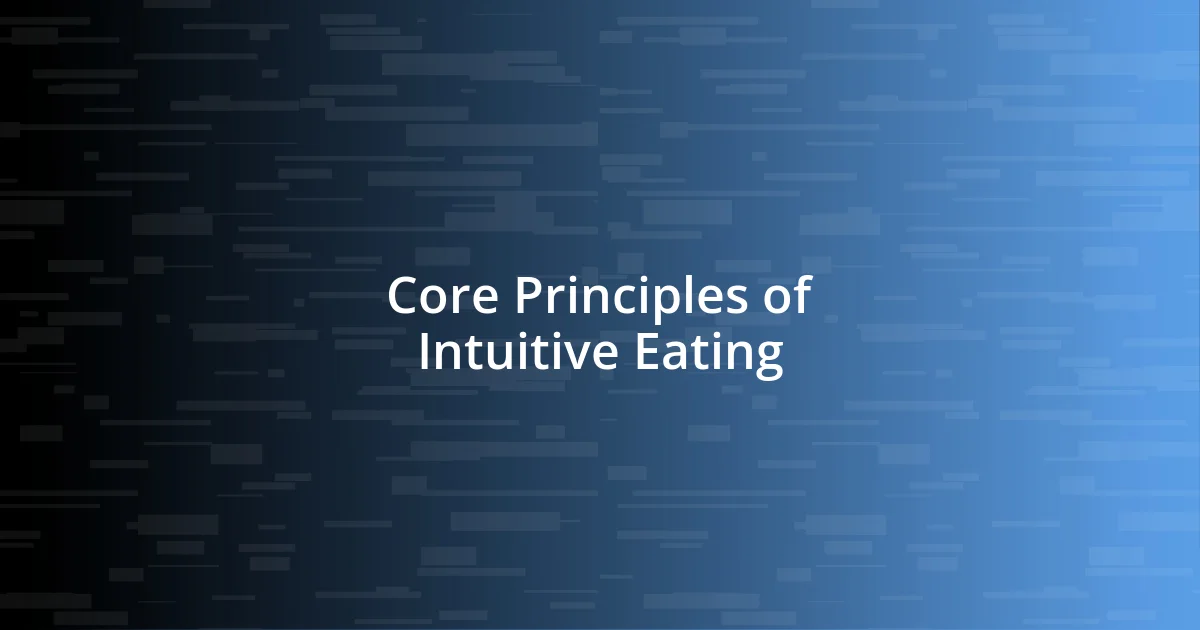
Core Principles of Intuitive Eating
The principles of intuitive eating are designed to reconnect us with our bodies and their needs, offering a refreshing break from diet culture. I remember a time when I had to relearn the difference between real hunger and emotional cravings. It was an enlightening moment when I discovered that I could pause, ask myself what I truly needed, and find clarity in what I craved at that moment.
Here are the core principles of intuitive eating:
- Reject the Diet Mentality: Let go of the idea that dieting is the only path to health. It was freeing for me to stop subscribing to those endless cycles of restriction.
- Honor Your Hunger: I found that respecting my hunger cues led to a more harmonious relationship with food, allowing me to avoid overeating later.
- Make Peace with Food: I’ve experienced how giving myself unconditional permission to eat any food diminished cravings and increased my satisfaction with meals.
- Challenge the Food Police: Silencing the negative self-talk around food was liberating. I began to enjoy my choices without constantly judging them.
- Respect Your Fullness: When I started to pay attention to my body’s signals of fullness, I realized just how satisfying it is to feel content instead of stuffed.
These principles have shifted my perspective on food and my body, creating a more positive environment for eating and living.
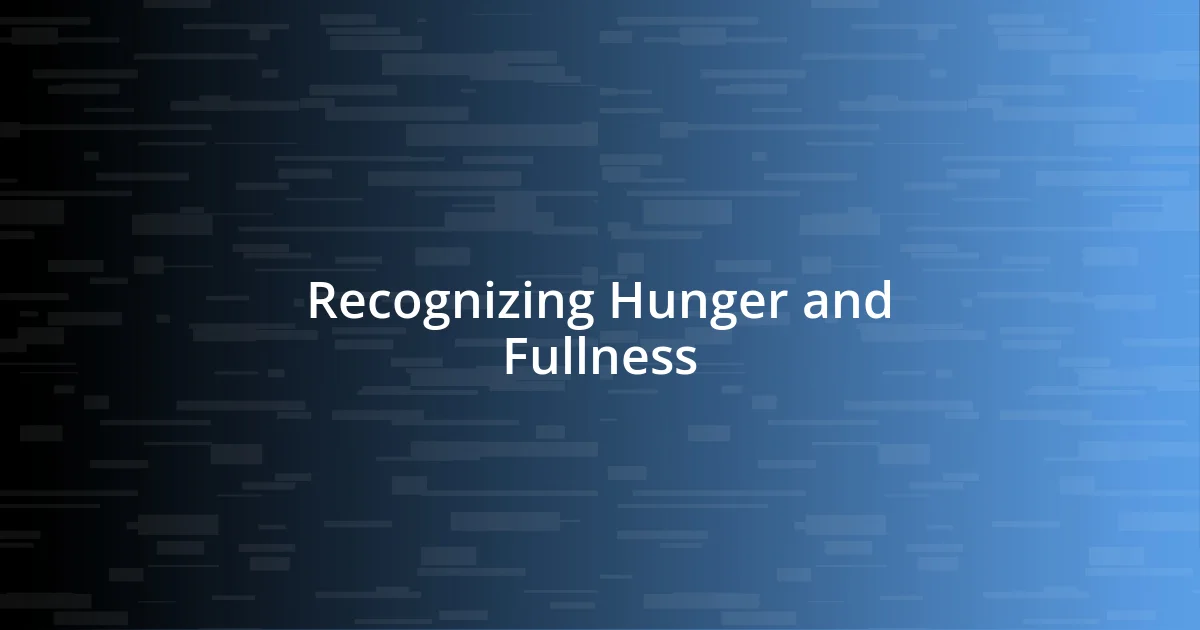
Recognizing Hunger and Fullness
Recognizing hunger and fullness is a key aspect of intuitive eating. I remember the first time I carefully tuned into my body’s signals, waiting for that gentle rumble in my stomach instead of snacking mindlessly. It felt like reconnecting with an old friend; I hadn’t realized how disconnected I had been from my own body’s needs. Have you ever felt that way?
As I began to practice recognizing fullness, I discovered a fine line between feeling satisfied and feeling overstuffed. One dinner stands out in my mind; I stopped eating when I felt pleasantly full, leaving a few bites behind on my plate. That choice was empowering and reinforced my understanding that it’s okay to leave food, especially when it’s in tune with what my body truly wanted. How often do we dismiss our own cues in favor of finishing what’s on our plates?
In my journey, I found that keeping a simple log of my hunger levels before and after meals helped me become more aware. Initially, it felt awkward, but over time, it became a natural way to guide myself. I began to visualize my hunger on a scale from 1 to 10. Reflecting on it now, I can see how valuable this practice was in transforming my eating experience into a mindful one. The more I embraced it, the easier it became to differentiate genuine hunger from emotional eating.
| Hunger Level | Physical Signs |
|---|---|
| 1 (Starving) | Weakness, dizziness, irritability |
| 5 (Neutral) | Comfortable, slightly hungry |
| 10 (Overstuffed) | Discomfort, sluggishness |
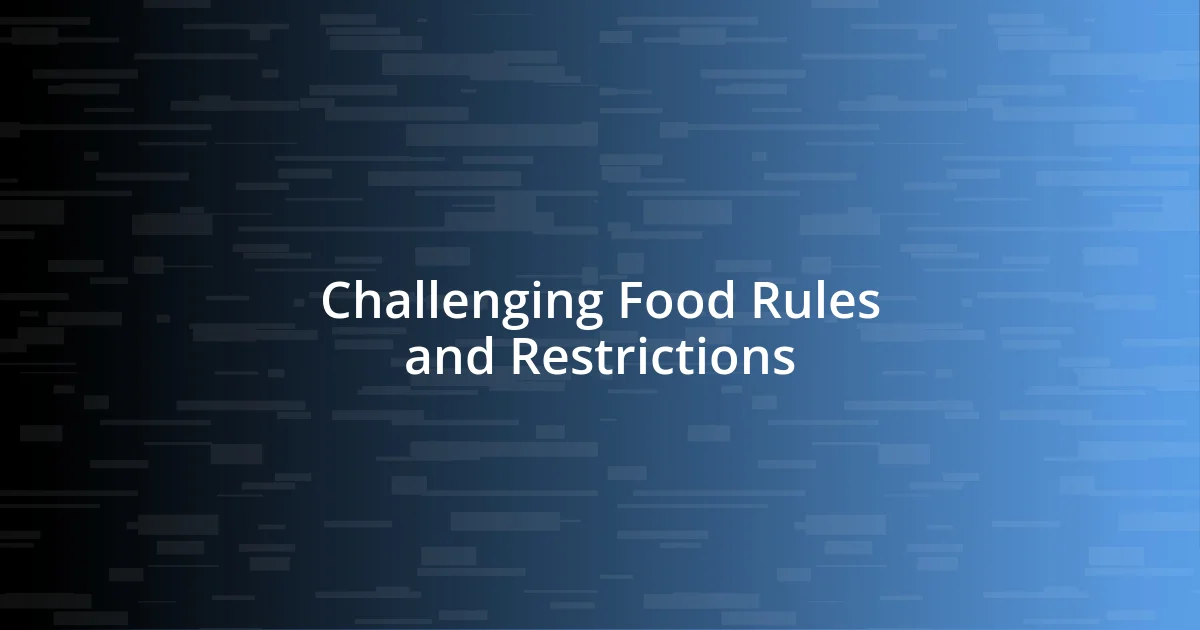
Challenging Food Rules and Restrictions
Challenging food rules and restrictions can feel daunting, but it’s a key step in my intuitive eating journey. I vividly remember when I had to confront my belief that carbs were the enemy. Letting go of that notion was like lifting a heavy weight off my shoulders; suddenly, I could enjoy a warm slice of bread without guilt. Have you ever considered how your food rules might be holding you back from true enjoyment?
When I challenge food restrictions, I focus on the emotions connected to those beliefs. One memorable evening, I indulged in a dessert I had labeled as “bad” for years. As I savored each bite, I realized that categorizing food as “good” or “bad” was a practice that only fueled my cravings. This experience taught me that breaking down those mental barriers not only enhances my eating experience but also nurtures a more positive relationship with food.
It’s crucial to recognize the power of language around food. Instead of saying, “I can’t eat that,” I’ve shifted to, “I choose not to eat that right now.” This subtle change has transformed my mindset. It’s a reminder that I’m in control, rather than a victim of my own rules. How freeing is it to shift from restriction to choice? I encourage you to experiment with this shift in your own dialogue; you might find it leads you to greater satisfaction and balance in your eating habits.
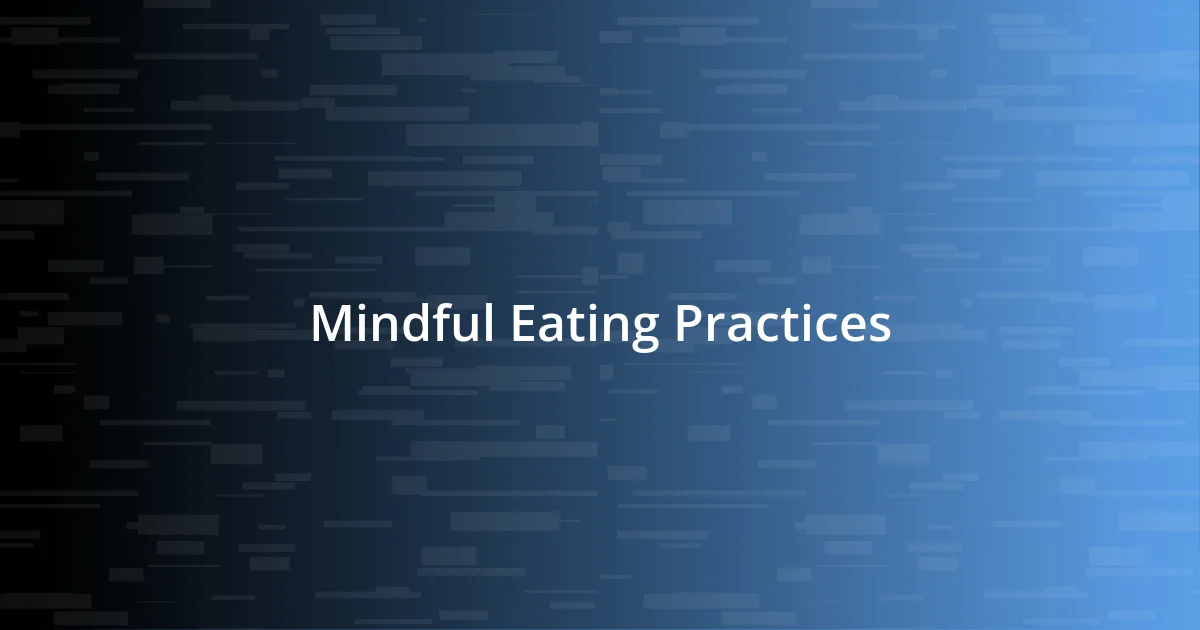
Mindful Eating Practices
One of the most transformative practices in my mindful eating routine is slowing down during meals. I once participated in a meal where we each took a full minute between bites to savor the flavors and textures. Initially, it felt strange, almost uncomfortable, but by the end, I realized I had actually enjoyed my food more deeply than I ever had in a hurried meal. Have you ever taken a moment to really taste your food, feeling the symphony of flavors dance on your palate?
I’ve also found that engaging my senses enhances the overall dining experience. For instance, I often close my eyes while eating to heighten my awareness of the aroma and taste of the food. One afternoon, while eating a simple bowl of soup, I noticed the warmth and comforting fragrance enveloping me. Suddenly, my meal became a mini celebration. Isn’t it remarkable how something as mundane as soup can become a sensory delight when we pay close attention?
Lastly, I’ve started incorporating gratitude into my meals. Before I eat, I take a moment to express appreciation for the food on my plate. This practice shines a light on the effort and energy that went into producing it. One day, as I sat with a vibrant salad, I silently thanked the farmers, the chefs, and the earth. It changed the way I viewed nourishment, making it feel sacred. How could bringing gratitude into your mealtime rituals reshape your relationship with food?
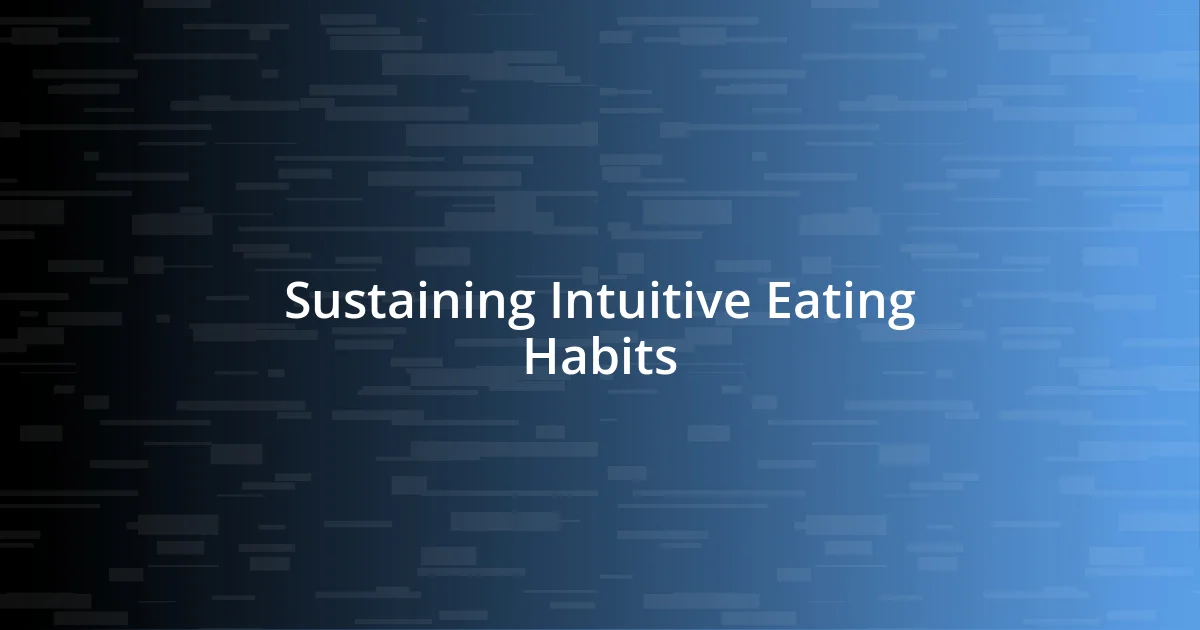
Sustaining Intuitive Eating Habits
Sustaining intuitive eating habits requires a continuous commitment to self-awareness. I remember a particular Saturday when I faced a buffet spread filled with my favorite dishes. Initially, I felt overwhelmed, but I took a moment to check in with my hunger levels and emotions. This practice of pausing to reflect helped me choose foods that not only satisfied my cravings but also felt nourishing. Have you ever noticed how tuning into your body can transform the choices you make at mealtime?
Another important aspect is creating a supportive environment. I’ve discovered that surrounding myself with like-minded friends who respect intuitive eating really bolsters my resolve. On a recent picnic, we shared a wide variety of foods without judgment, and I felt liberated to eat what my body craved. Isn’t it incredible how community can reinforce the habits we want to sustain, helping us feel less isolated on our journey?
Lastly, I make it a point to revisit my intentions regularly. Periodically, I sit down and reflect on why I chose intuitive eating in the first place. One afternoon, as I jotted down my thoughts, I realized how much my mental clarity had improved. Writing helped me stay connected to my values, reminding me that it’s not just about feeding my body, but nurturing my spirit, too. Have you considered journaling as a tool for sustaining your intuitive eating practice? It’s a simple yet effective way to check in and strengthen commitment to this nourishing lifestyle.
